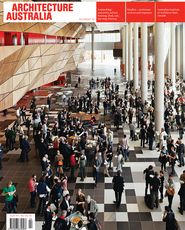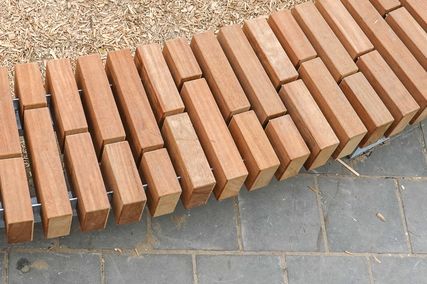RESTLESS / POLISHED / ENERGETIC
ANDREW NIMMO
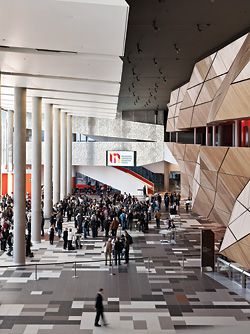
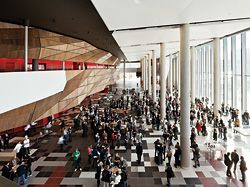
Delegates mill in the foyer of the new Melbourne Convention Centre, designed by NHArchitecture in joint venture with Woods Bagot. Parallax was the first public event at the new venue. Photography Peter Bennetts.

The audience.

Slavoj Žižek in discussion with Richard Blythe.
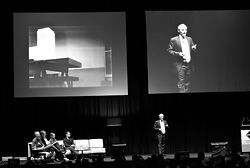
Aaron Betsky.
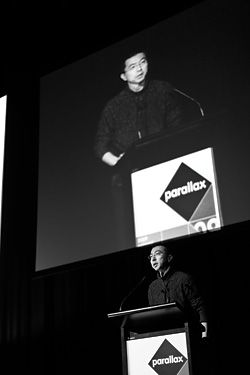
Sou Fujimoto.
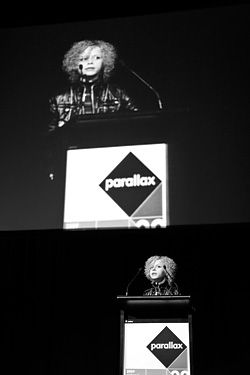
Veronika Valk.
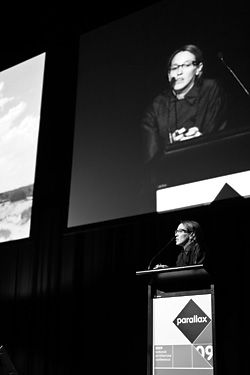
Tatiana Bilbao.
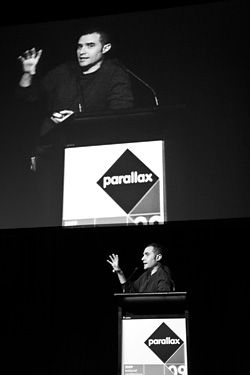
Alejandro Zaera-Polo.
After reading the pre-event promotional writings for Parallax – which seemed to tell us as much about how Terroir run their studio as about the lineup – I was ready for three days of shameless self-promotion by the Terroir boys. But that is not how it turned out. To their credit, the three creative directors, Gerard Reinmuth, Scott Balmforth and Richard Blythe, sat back for the most part and let the show run its course, without trying to stage-manage the content into any particular message. Apart from the final session, which desperately needed a facilitator, their hands-off approach worked well.
The conference was framed around a series of themes – studio, media, politics, young guns, collaboration and cosmopolitan – all under the umbrella of Parallax, a reference to Slavoj Žižek’s 2006 opus (not Alan Pakula’s 1974 film). Each theme involved a pair of speakers, plus a facilitator to generate discussion. However, the real dynamic revolved around the accidental tripartite of Peter Wilson, master architect; Slavoj Žižek, frenetic philosopher; and Aaron Betsky, urbane architectural critic. Their weight and experience were balanced against the other speakers, who were mostly young, energetic, idealistic and still formulating their place in the world.
Studio
The opening presentation by Peter Wilson of Bolles + Wilson was a highlight. As an expatriate Melbournian working in Munster, Germany, via fourteen years at the Architectural Association in London, and with a body of work the envy of most of our Gold Medallists, Wilson had nothing to prove. His presentation was sincere and modest, without the polish that we expect of today’s generation of performing architects. As background, Wilson took us back to the AA design laboratory of the late Alvin Boyarsky (the 1970s and 80s), when young unknown tutors were allowed to develop into the next generation of influential practitioners – Zaha Hadid, Bernard Tschumi, Nigel Coates, Daniel Libeskind and Rem Koolhaas were all teaching contemporaries of Wilson at the AA before they became celebrity architects. He went on to remind us that architecture needn’t necessarily be iconic and showed how relatively small interventions, such as a paint scheme for a block of units in Albania, could generate discussion among people about their built environment.
This was in direct contrast to the slick, though at times inane, presentation by Winka Dubbeldam. Dubbeldam seemed more intent on peddling her postgraduate Masters degree course at the University of Pennsylvania than on explaining the strategic intentions of the work. Strangely, the projects she presented (only one of which was built), though radically different in program, all inclined to the same organic articulation of biological tendons and gristle structure. Her FTF mantra (File-to-Factory) lacked the real conviction that Edwin Chan of Frank Gehry’s office showed us later in the conference.
Media
Aaron Betsky continued from where he left off at the Venice Biennale – evangelizing about architecture beyond building. He is very comfortable on stage and easy to listen to. He called for us all to move beyond the predictable outcomes and self-satisfaction that comes with completing a major project. Betsky is the eternal critic – wherever you have reached, there is somewhere new to go. Agitating and reminding us that there is no end point to design is exactly what the independent critic should do (though he is something of an intellectual bully when a soft target is presented). Where he lost me a bit was in the rollcall slideshow of art installations dressed up as architectural innovations from the Biennale. It just reaffirmed that architects make good architects, but mediocre artists.
Geoff Manaugh, speaking like super-fast broadband, presented us with a world where everyone has an opinion and all are valid. It is pluralism to the nth degree, where the elites of the academies have been replaced with the opinions of everyone else. Through his website, Bldg Blog, Manaugh has assembled a chronicle of architectural commentary and useful links. Where opinions and ideas are presented, but not necessarily challenged. Where a snappy one-liner might have more cachet than a lifetime of research. However, the immediacy of the blog has an appeal, as in architectural journals issues have often run their course by the time of publication.
Politics
Alejandro Zaera-Polo, co-founder of the London-based Foreign Office Architects (FOA), displayed both his strong theoretical background and his political standing influenced by Neo-Marxist authors. Through a materialist critique of architecture he argued that the marketplace was divided into two categories, the “Expensive” and the “Cheap”, and that the politics of architecture could more effectively be played out at the cheap end, which is the bulk of the market. FOA is practising this approach on a massive scale across Europe and Asia.
Politics and the emergence of Estonia from the dark ages of Soviet control are intertwined. There is so much in Estonia to re-inhabit, re-take and re-make. The crumbling Soviet-era infrastructure presents both a liability and an opportunity for Veronika Valk of ZiZi&YoYo, as she sees applications for design interventions everywhere. Her work is not precious or style-based but highly pragmatic. Very little of her presented work was “architecture” – yet it was architectural in its approach to releasing the potential of the public realm.
Young Guns
This was the most annoying of the topics and probably the most disappointing of the paired presentations. If the aim was to show that architects under forty should be set loose on the public realm, then Tatiana Bilbao from Mexico and Sou Fujimoto from Japan did not sell us the theme.
Though practising in the world’s largest and most unplanned city, Mexico City, Bilbao as yet has nothing to offer it. Her presentation showed little by way of a social contract in her work. Within Mexico, her interest lay in the privileged world of famous artists and philanthropic businessmen – at least, that’s what was mainly presented. It was a shame that she did not tell us more about the Planta de Liquidos, a massive cultural centre in Guadalajara, Mexico, spread over 66,000 square metres.
Fujimoto offered up a highly deterministic and culturally specific view of the world. You do not occupy his buildings – you adapt to them. He focuses on a program that consciously ignores the real complexity of life, love and ablutions. You can admire the poetic simplicity and single-mindedness of his House N, a box within a box within a box in stark white, but the result is a seriously crazy piece of architecture. As was his Tokyo Apartment project, which looked like a stack of Monopoly houses. Fujimoto may yet grow into the next Toyo Ito and fulfil Betsky’s challenge.
Collaboration
Bijoy Jain of Studio Mumbai was the surprise delight of the conference. His humble presentation detailed how, as a young and highly educated architect returning to India after several years studying and working in the US, he was going to transform his native city. Instead the traditional craftsmen of Mumbai transformed Jain. We did not see enough of his beautifully crafted work, as he spent much of his allocated time explaining the way he works. I could quite happily have listened to him for another two hours.
Edwin Chan, a partner of Gehry Partners LLP, has collaborated with Gehry for over twenty years and worked on many of the most iconic Gehry projects. What was interesting in Chan’s presentation was not the projects, which are beginning to look like parodies of each other, but the way the office works – from initial Gehry sketch or scribble through to a sculpturally expressive model, then digitization of the model to create the basis for the documentation.
Cosmopolitan
Getting Slavoj Žižek to the conference was something of a coup for Terroir. Little known in architectural circles, Žižek is a superstar in the world of Lacanian Marxist philosophy and cultural critique. He has not written on architecture before and his observations during the conference were not especially insightful, though highly amusing.
There is a great danger in architects assimilating complex philosophical theories into architectural manifestos. The banal borrowings of Deconstruction and the writings of Derrida in the 1990s is a case in point. The parallax view as espoused by Žižek never really worked its way into the conference itself. However, it was a catchy name and was expanded into the slightly naughty “parallaxed” for late night critique and architectural boozing.
Wrapup This was a very successful conference, though perhaps not in the way that the creative directors intended. The parallax theme never really took us anywhere, but Žižek’s restless intellect was the perfect foil to Betsky, the polished critic. The six themes were pertinent and the collection of presenters generally kept to script. What worked particularly well was the insightful pairing of the speakers, which showed a real understanding of who they were and what they had to offer. Terroir clearly did their research very thoroughly.
Andrew Nimmo is a director of Lahz Nimmo Architects.
POLEAXED
KAREN BURNS
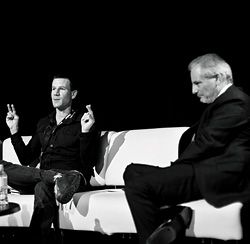
Geoff Manaugh and Aaron Betsky on the media panel.
A national architecture conference is a heady mix of event genres – part trade fair, red carpet star gazing, social events, networking opportunity, public relations display and conference symposium. The constellation of functions ensures that it has something for every occasion and something for every participant. But it is a difficult genre to program. Making sense of its landscape of attractions is a challenge for both the creative directors and the audience. The review that follows is of necessity partial, since the long days, the night-time activities and the ten parallel afternoon sessions could not physically be experienced by any one participant. Instead I will explore some of the key questions and tensions arising from the Parallax curatorship of architecture’s emergent counter-narratives, these new structures of explanation still vulnerable to the shadows cast by our mythic stories.
Terroir, the creative directors of Parallax, were aware that a conference is an event and not just a list of names and presentation titles. In their program notes they declared that they had “set out to design a conference that was more than the sum of one hour lectures by invited guests.” They designed a format of dialogue and conversation, ensuring that all sessions had at least two speakers and more often than not a third whose role was to facilitate, energize and intervene – to transform presentations into conversation. The audience was encouraged to send questions via SMS and although the technology is still somewhat fraught it was an admirable idea. The problem for any curator is the scale of the audience. One thousand people in the keynote sessions circumscribe the ways in which the intimacy of conversation and the ragged surprise of audience participation are easily ambushed by the public spectacle of big names on stage. I am not sure how to overcome this. Smaller parallel sessions promote keener engagement by their diminished size, and yet they also fragment the larger social body. Perhaps new technologies could be used to present the parallel sessions on the web, to be downloaded immediately afterwards. A conference blog could allow participants to interact with sessions they have been unable to attend and offer a space for running commentary on the conference as it unfolds. However, managing this technology feels like a recipe for binge drinking.
The commitment to event, a conversation in progress, revealed a determination to refuse the format of the single author’s voice and the authoritative point of view. An idea, a formation, a phenomenon could be multiple and thus contested or inhabited by difference. Sessions were organized by idea – studio, media, politics, collaboration, young guns and the cosmopolitan – a structure offering a magnetic pole for a geography of differing approaches. The organizing categories, however, were sometimes overrun by other recidivist forces. The title “young guns” suggested an unfortunate commitment to avant-garde alliances of the novel and the youthful. The isolation of the theme “collaboration” suggested that collaboration was an exception in architecture. We know that the complex process of procuring, designing and executing buildings is a carefully managed process of professional boundaries, contracts, office hierarchies and stratified roles. The “cosmopolitan”, a category occupied by visiting Slovenian philosopher Slavoj Žižek and Spanish architect Alejandro Zaero-Polo, seemed a European possibility. Oh dear. Are we still provincial? When will we ever catch up?
The problematic relationship of the global to the local was a conversation starter in many of my exchanges with other audience members. It is a difficult issue. Conferences need to be financially viable and there is a perception that “big names” draw audiences – and big names seem to be a code word for internationals. The role of the visiting speaker who descends from the “north” has undergone a remarkable transformation in the last ten years. Throughout the 1980s a determined group of architects organized the International Architecture Lecture Series in Sydney and Melbourne. Before the internet, before the emergence of many international architecture and design journals, before blogs, before email, before more extensive postgraduate placement of Australians in overseas universities, this series offered a chance to see emergent and star international architects presenting their practice. These were heady events of prodigious intellectual belligerence and aggressive social fraternization. But now that we are all globalized through information culture, the question must arise as to the function of visiting overseas speakers. The curators surely understood this, in programming events, not lectures, but nonetheless a local/global hierarchy emerged through the structure. The big, theme sessions were dominated by visitors and the parallel studio sessions saw local practitioners teamed up in dialogue with a visitor. Unconsciously, perhaps, a binary emerged.
Contemporary Australian architectural practice has detonated the boundary of global/local. A number of firms work across national boundaries (Denton Corker Marshall, ARM, Lab, Bates Smart, for example) and a number of practitioners and academics have stellar, global reputations, such as Tom Kovac, Leon van Schaik and Mark Burry as designer researchers and practitioners, and the theorists John Macarthur, Bill Taylor, Stan Fung, Gevork Hartoonian and Charles Rice, with the emergent voices of Pia Ednie-Brown and Naomi Stead. The presence of these figures in discussing the nature of a globally situated practice, but one based in Australia, would have extended and contested the “unconscious” binary of global/local. As it transpired, a number of the visiting speakers described work interconnected with local conditions: Veronika Valk in Estonia, Tatiana Bilbao in Mexico, Bijoy Jain in India. Against the grain of the conference program, an understanding emerged of the global and the local as intriguing oscillating conditions, of transnational practice (Foreign Office Architects, Bolles + Wilson, Archi-Tectonics), and of situated local places in global information and political networks – Veronika Valk on the remaking of Estonia in the wake of the collapse of the Soviet Union, Tatiana Bilbao on the Mexico/US border and the drug trade, and Studio Mumbai on the economic, customary and physical conditions of building. Global and local are intermixed conditions but sometimes our polemics render them silos.
I want to discuss two other possible silos before I finish this review. The first is the problematic space given to theory in the conference program. During Parallax one of my friends claimed, positively, “This is a theory conference.” When I asked why, he countered that it was because Žižek was one of the main speakers. Žižek, a Marxist, a psychoanalyst, a post-structuralist, brings the rigour of those disciplines to bear on Hollywood cinema, contemporary events such as 9/11 and the emergence of the public “performance arts” venue. Žižek is the exemplar of the public intellectual and the architecture-friendly theorist. He engages his audience through the storytelling event, marshalling anecdotes to unfold some of the difficult terms and critique offered by theory. Whether it is a reading of excrement as a culturally determined marker of identity (Germans examine the contents of the toilet pan differently from the English and French) or the collision between the phantom of the democratic, inclusive “public” realm and that realm’s foundation in exclusion of those who lack citizenship, Žižek is audience-friendly. The creative directors are to be congratulated on the inspired choice of Žižek. Although he first started publishing in English in 1986 in the high-profile cultural literati Manhattan-based art journal October, and MIT Press published his first English book, Žižek has had little formal interchange with architecture. Nevertheless the problem remains, what is the function of the theorist who is largely outside architecture? His insights are prized because they can be creatively transposed into our discipline but his passing familiarity with architecture always renders him vulnerable to the charge of amateur knowledge.
In discussion Betsky and Zaero-Polo were able to correct Žižek on the complex architectural formations, already anticipating the charges Žižek laid at architecture’s doorstep. My suggestion would be that we detonate this problematic opposition of outsider/insider by also inviting mediating figures – theorists who work in architecture and with the material a philosopher like Žižek engages with. For example, the Melbourne theorist Brenda Marshall has worked with psychoanalysis and architecture, and Hélène Frichot has theorized those sites of exclusion, the detention camps determined for non-citizens and “illegal” aspirants to space in Australian culture. Architectural designers of new museum spaces have worked thoughtfully and energetically around the issue of the new public arts venue and the entry of “excluded” communities, as Denton Corker Marshall did at the Museum of Victoria and ARM and Robert Peck von Hartel Trethowan did at the National Museum of Australia. These mediating figures would go some way to undermining the binary of the exotic theorist, foreign to architecture, in difference to those on the “inside”, in the practice of the discipline.
My final silo is the question tacked onto the workshop session with Tatiana Bilbao and Shelley Penn, Associate Government Architect of Victoria: “Why are there so few women in architecture?” This seemed a rather curious addendum to a session devoted to new kinds of public architectural practice. Bilbao and Penn seemed to be asked to perform their difference and apparent “marginality”. The answer to the question could have been reframed for a larger session in two ways. In 2005 the then Royal Australian Institute of Architects supported the publication of a report, “Going Places: The career progression of women in the architectural profession” by Dr Paula Whitford. Her findings supplemented an earlier RAIA report published in 1986 on women in the profession. These two documents offer a fine, informed basis for discussion about the impact of family/life balance, career goals, studio culture and the problems of perceived gender difference. The conference event offered its own startling configurations of gender cutting across the question of women’s limited participation.
Three of the keynote speakers were women (Winka Dubbeldam, Valk and Bilbao) and two other global keynote speakers work in partnership with women (FOA and Bolles + Wilson). At the local level of invited participants the lack of women practitioners was more noticeable. Among the ten parallel workshop sessions teaming internationals with locals, Shelley Penn was the only local woman architect, although local academic and digital practitioner Pia Ednie-Brown teamed up with Veronika Valk to present an energetic installation event. However, two local practices selected for the conference, Minifie Nixon in the workshop sessions and Elenberg Fraser in the evening studio crit, also have women directors, although they were not present. Thus, a more refined version of the question addressed to Penn and Bilbao emerges: why were there so few local women practitioners present in the conference program, when of the eight invited international architectural practices (not the curators, theorists and bloggers), five practices have women co-directors? Food for thought, or perhaps I was witnessing another configuration of the global/local polarity. The “blood on the floor” format of the conference bar room Friday night crit confirmed some of the findings of Whitford’s 2005 report – that this aggressive critique style is problematic for some women (and some of the men I spoke to who had witnessed the “critique”). These peculiar formations of the conference are not the sole responsibility of the curators but they do suggest that the “theoretical” question of marginality is not separate from other issues of speaker choice and traditional format. In other words, the question is central to the conference’s organizing structure and not outside it.
Out of all this, I was alternately charmed, positively surprised, informed, extended, provoked and irritated. It was not a bland conference experience. I rarely felt endorsed in my preconceived ideas. I was poleaxed by Parallax: left exhausted and overrun by numerous talking points. I had been submerged into a dense configuration of material, conversations and encounters. I was stimulated into thinking. The event was not a self-contained show but a starting point for arguments and the content of future Institute conferences. It is life-enhancing that these events work on an old-fashioned, annual time schedule. We have one more year before we do this again, and twelve months to extend these provocations into an ongoing conversation.
Dr Karen Burns is an architectural theorist and historian. She teaches in the architecture and design programs at the Faculty of Art and Design, Monash University (Caulfield).
INSPIRED AND FRUSTRATED
KATELIN BUTLER
A national architecture conference should engage its audience, provoking further thinking, further questioning. It should frustrate and inspire. Parallax did just that. Terroir based the conference on six main themes, but naturally these themes digressed into other avenues of architectural discussion, according to the intent and preoccupations of the speaker. There was an emphasis on new technology, both in content and in the format of the conference itself. For example, in the keynote addresses the audience was asked to “text in questions”. This had the potential to generate concise, direct questions and avoid the often long, convoluted monologues that sometimes rise from an audience during question time. However, pitfalls soon became apparent as questions were reduced to humorous banter – “Geoff, are you single?” Nevertheless, although the texting didn’t generate serious and stimulating debate, it did bring some fun to the event and it was an admirable attempt to bring technology actively into the conference structure, rather than just speaking about it.
The program was kickstarted by SuperTute, which gave the students an opportunity to pick the brains of some of the “masters” and to gain a new perspective on their work. The tutors for the event were a mix of local and international architects and academics, with each student having two tutorials. Disappointingly, not all students who registered attended, although this did give others more opportunity for discussion. I was privileged to talk with Veronika Valk, an Estonian architect from ZiZi&YoYo, who later spoke in the politics session. Her sensitivity and connection with her city were particularly inspiring – at the junction of art and architecture, her work has a clear social conscience, and this was the emphasis in her invaluable advice.
Peter Wilson began the conference proper addressing the topic studio, in which he was followed by Winka Dubbeldam. Framing the speakers in terms of the six themes placed the emphasis on the ideas and content rather than the individual. The following day, in the media session, Geoff Manaugh from Bldg Blog preached the advantages of blogging, exploring the immediacy of the web and the way in which it makes architectural dialogue easily accessible to a worldwide audience. Manaugh emphasized the importance of hearing the voices of everyday people – as opposed to architects thinking and talking about architecture within a small circle. Although he tended to repeat himself, he inspired many in the audience to think of starting their own blog. It did, however, leave me wondering about the explosive nature of this type of media – Manaugh himself shared similar concerns, noting the enormous number of architectural blogs now online. Manaugh was paired with Aaron Betsky, former head of the NAI, curator of the 2008 Venice Biennale and currently director of the Cincinnati Art Museum. Betsky’s bold presentation digressed to the nature of architecture itself – where “architecture” is what happens before the building is built, and is a medium in its own right. There was a tension between these two speakers and their approach to media, which stimulated both frustration and curiosity.
In the architecture presented in the following sessions, there was a careful balance between the use of new technology and an engagement with the notion of the craftsman builder. In both cases, aesthetics played a key role in discussion. As was pointed out a number of times, aesthetics – although vital – is often a taboo topic, so it was interesting to see this debate unfold.
Parallax had a clear emphasis on international architecture rather than Australian. This was disappointing. The only way to hear voices of local architects was in the smaller workshops, which paired an international speaker with a local architect. Ten of these were held over the last two days of the conference, but timetabling meant it was only possible to attend two workshops. Approaches varied. Pairing Aaron Betsky with Ingo Kumic induced fiery debate that actively engaged the audience, whereas the “spatial intelligence” workshop with Allan Powell and Sou Fujimoto was a “show and tell”.
Terroir wanted to inject some playfulness into a traditional event – graphics, music, introductions and choice of speakers. There was also a clear alignment between the chosen speakers and the work of Terroir as a practice. The creative direction might be seen as self-centred – Terroir are not afraid of this, showing a boldness in their approach. However, while the mix of presenters was successful, the overall content seemed to emphasize a rather indulgent form of architecture – an architecture that does not deal with the “nitty gritty” of the business of architecture. In a sense, the conference seemed to glamorize architecture and to avoid the social and environmental issues of the discipline.
The final session saw the vigorous philosopher Slavoj Žižek tackle “the cosmopolitan”. The invitation of Žižek to the conference was itself a point of debate among the audience – some saw it as an attempt to place emphasis on theory, rather than practice. With last year’s conference focusing on sustainability, perhaps it was a considered decision of the creative directors to present a conference with different priorities. The name of the conference came from Žižek’s book, The Parallax View – so his grand performance was a suitable conclusion to the keynote addresses.
For a young person entering the professional world of architecture, attending the national architecture conference is vital. Opening up the mind and eyes to what’s happening locally and globally in architecture is not only rewarding at the time, but is an experience that will contribute to the development of personal opinions and priorities in an ongoing way.
Katelin Butler is the assistant editor of Architecture Australia and a final-year architecture student.

